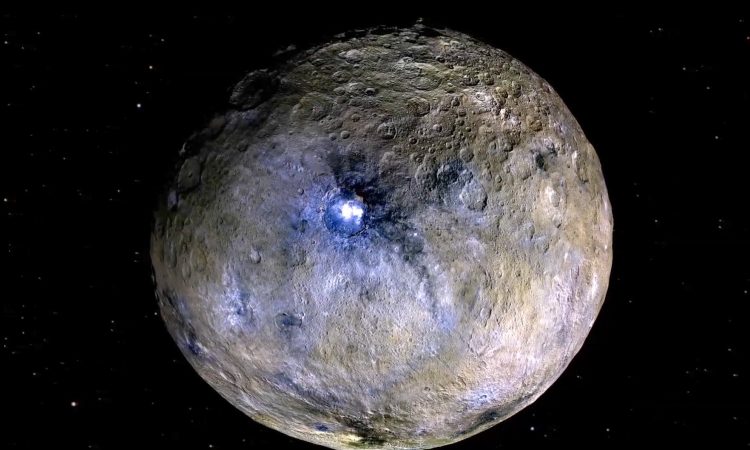
Scientists have used data from NASA’s decommissioned Dawn spacecraft to solve the mystery surrounding the origin of the strange dwarf planet Ceres.
Ceres is currently in the main asteroid belt between Mars and Jupiter, and most theories of its creation suggest that it was born there as well. However, this dwarf planet has some strange features that set it apart from other objects in the main asteroid belt.
This has led some scientists to speculate that the 600-mile-wide dwarf planet may have originated at the outer edge of the Solar System and migrated inward.
Not only is it from the main asteroid belt, but it also appears to have a more complex geology than its fellow occupants. A particular enigma is the presence of frozen ammonia on Ceres, which the Dawn spacecraft discovered when it studied the dwarf planet between 2015 and 2018.
Ammonia is thought to be stable only in the outer Solar System, away from the sun and the radiation that causes it to evaporate. Therefore, its presence suggested that Ceres may have formed far from its current home.
Now, data collected from one of the oldest impact craters on Ceres, the 64 km wide Consus crater, could dispel the migration theory and show that the dwarf planet did indeed form in the main asteroid belt, writes .
Ceres is in the main asteroid belt between Mars and Jupiter
“At 450 million years old, the Consus crater is not particularly old by geological standards, but it is one of the oldest surviving structures on Ceres,” said Ranjan Sarkar, a researcher at the Max-Planck Institute and a member of the team. “Due to its deep excavation, it gives us access to the processes that have taken place inside Ceres over several billion years – thus providing a kind of window into the dwarf planet’s past.”
Ceres is a cryovolcanic body with volcanoes that do not spit hot lava, but glacial mud. This frozen volcanism has driven the evolution of the dwarf planet over billions of years and may still be occurring today.
The study of the Conus crater, one of the smallest, located in the southern hemisphere of the dwarf planet, revealed the remains of a brine that rose to the surface of the dwarf planet from inside it, more precisely from the liquid layer between the mantle and the crust, over billions of years.
While most of the deposits found in Ceres’ scattered impact craters show light-colored, whitish salt deposits, the material in isolated spots in Conus Crater has a more yellowish hue. This material appears to be rich in ammonium, a type of ammonia with an extra hydrogen ion.
The planet could have come from the outer edge of the Solar System
Scientists previously thought that the process needed to create ammonium would not have worked as close to the Sun as the main asteroid belt because it evaporates too quickly. These new findings are the first to link ammonium to brine, supporting the idea that Ceres is an asteroid originating in the asteroid belt.
To reach their conclusions, the team assumed that the constituent elements of ammonium were part of the material that originally formed Ceres. Because it would not have combined with other materials in the dwarf planet’s mantle, a thick layer of ammonium would have accumulated in the brine between the mantle and the surface or crust of the dwarf planet. This blanket of ammonium would have spread over the entire surface of the planet Ceres.
Over billions of years, Ceres’ cryovolcanoes would have brought this brine and its ammonium content into the crust, where it would have seeped into layered crystalline structures called phyllosilicates.
Outside of Consus Crater, visible patches of the bright yellow material the team investigated are found in the deep craters of the planet Ceres. This suggests that ammonium concentrations are actually higher deep in the dwarf planet’s core.
Researchers believe that patches of this yellowish, ammonium-rich material east of Consus Crater were exposed by an asteroid collision about 280 million years ago.
The team’s research is published in

